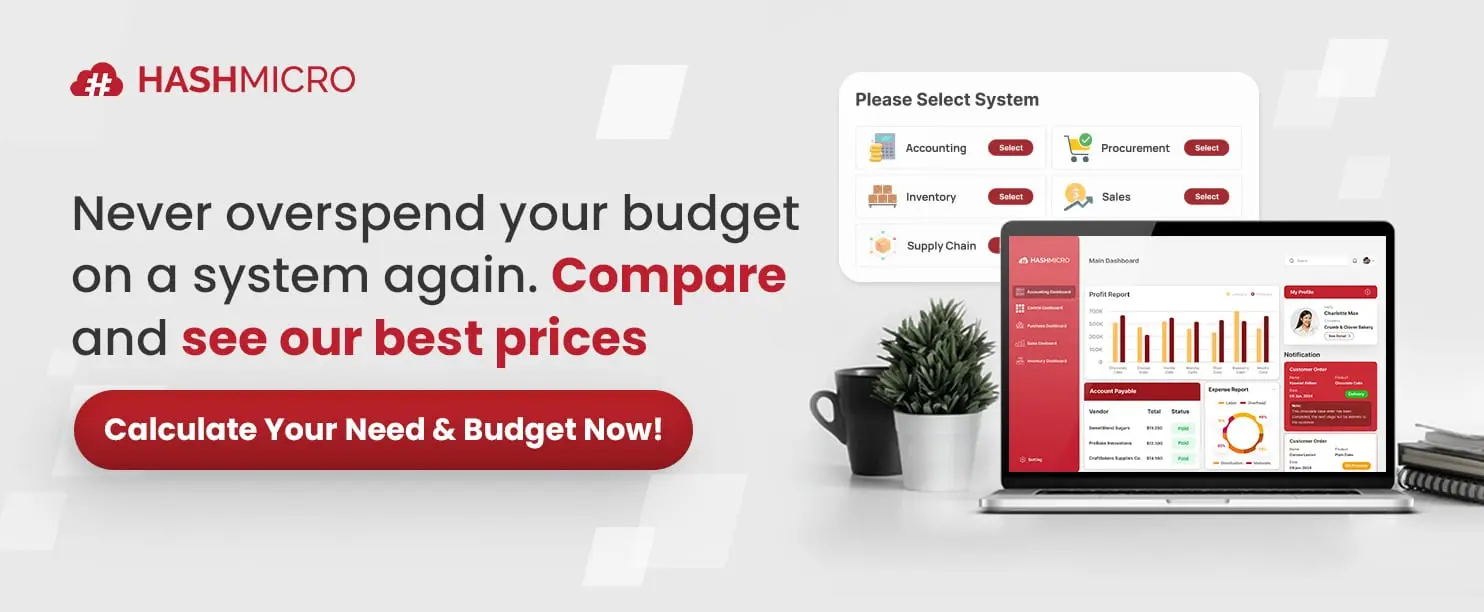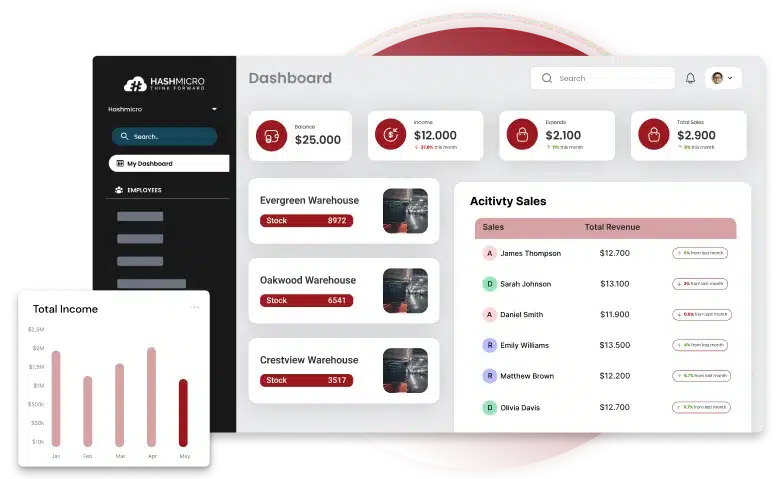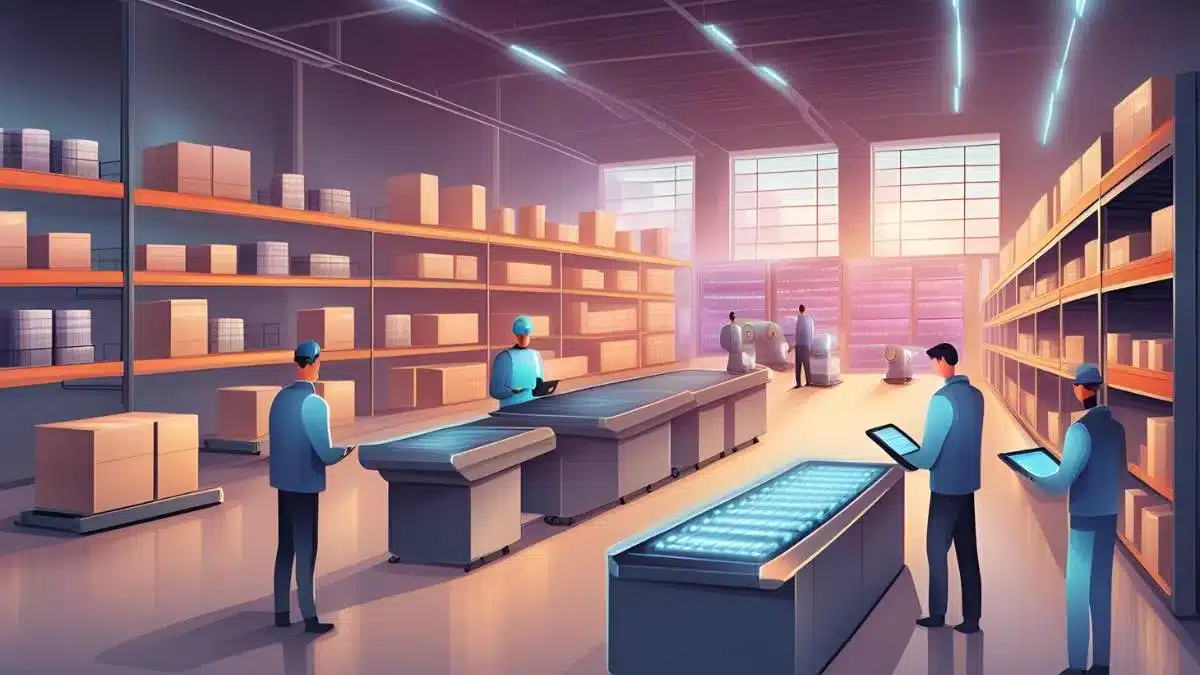A Warehouse Management System (WMS) is essential for any large logistics or supply chain business, helping manage key tasks like yard management, order processing, and inventory control. By automating receiving, picking, and shipping, a WMS makes warehouse operations more accurate.
With 87% of warehousing, logistics, and retail decision-makers planning or already develope their warehouse by 2024, manual tools like spreadsheets and physical counts are no longer sufficient due to frequent errors and limited visibility.
In this article, we’ll answer the question, “What is WMS?” and explore the core functions, types, and benefits of WMS. If you’re considering a solution, you can also try a free demo from HashMicro to see how it fits your needs.
Key Takeaways
|
What is WMS (Warehouse Management System)
A Warehouse Management System (WMS) is software that helps businesses control daily warehouse operations, from receiving goods to shipping them out. As part of supply chain management, it provides real-time visibility into inventory inside the warehouse and in transit.
Beyond tracking inventory, a WMS supports picking, packing, resource allocation, and data analysis. It is mainly used by warehouse managers and can integrate with systems such as ERP, CRM, TMS, and inventory management platforms.
Hashy AI Fact

Need to know!
Hashy AI from HashMicro enables you to manage the warehouse through product dimension tracking, automated in-depth reporting, and warehouse pallet racking.
Request a free demo today!
How Does a Warehouse Management System (WMS) Work?
A Warehouse Management System (WMS) works by automating and streamlining warehouse operations, ensuring efficient inventory control, order fulfillment, and real-time tracking.
Usually there’s been a debate between ERP vs WMS, but in reality WMS integrates with other business systems such as Enterprise Resource Planning (ERP) and transportation management software to create a seamless supply chain process.
At its core, a WMS operates through key functionalities:
- Receiving: Oversees incoming goods, checks quantity and quality, and assigns to optimal storage locations based on type and demand.
- Inventory Management: Monitors inventory levels, locations, and movements in real-time. Uses barcode scanning and RFID to help prevent stockouts and overstocks.
- Order Fulfillment: Coordinates picking, packing, and shipping to minimize delays and improve order accuracy.
- Storage: Selects storage locations based on item characteristics, demand frequency, and warehouse layout. Improves space use and reduces storage costs.
- Shipping: Handles the final steps of order fulfillment, such as generating shipping labels and coordinating with delivery carriers.
By leveraging automation and real-time data, a WMS minimizes human errors, reduces labor costs, and increases overall warehouse efficiency.
How to Use WMS?
A Warehouse Management System (WMS) streamlines warehouse operations, making inventory management more efficient. Here’s how to use WMS it effectively:
- System Setup and Integration: Start by configuring the WMS to fit business needs. This includes setting up warehouse zones, product categories, and integrating it with ERP and supply chain software for seamless operations.
- Inventory Data Input and Tracking: Input product details, stock levels, and storage locations into the system. Using barcode scanners or RFID helps warehouse automate tracking, ensuring real-time visibility and reducing errors.
- Receiving and Storage Optimization: When stock arrives, WMS records the data instantly and suggests the best storage locations. This ensures efficient space utilization and faster product retrieval.
- Order Processing and Picking: The system prioritizes orders and provides picking instructions to warehouse staff. Optimized routes reduce picking time, improve accuracy, and speed up fulfillment.
- Packing and Shipping Management: After picking, the WMS verifies items, generates shipping labels, and selects the best carriers. It also tracks shipments in real-time, ensuring smooth deliveries.
- Performance Monitoring and Reporting: Warehouse Management System (WMS) provides real-time analytics on stock levels, order accuracy, and warehouse efficiency. Businesses can use this data to refine processes and improve productivity.
- System Maintenance and Adjustments: Regularly updating Warehouse Management System (WMS) settings based on demand changes helps maintain efficiency. Reviewing reports and adjusting workflows ensures optimal warehouse performance.
By following these steps, businesses can maximize WMS benefits, reducing errors and improving overall warehouse efficiency.
What are the Benefits of Using Warehouse Management System (WMS)

A robust, digital warehouse management system (WMS Malaysia) is essential for businesses with inventory, offering cost savings and increased efficiency. Here are the top six WMS benefits for warehouse improvement:
1. Increased efficiency
A WMS enhances the efficiency of warehouse and logistics operations by streamlining the movement of goods, which improves every step of the fulfillment process with better efficiency, consistency, and quality control.
According to a Logistics Magazine survey, the warehouse is the most commonly cited place for packing and fulfillment activities. Moreover, ResearchGate estimates that order picking accounts for 55% of the total cost of warehousing.
Therefore, a WMS helps increase productivity by optimizing warehouse layout, ensuring easy access to product locations, maximizing space utilization, improving workflow to prevent bottlenecks, and reducing floor traffic.
Additionally, warehouse management improves efficiency by maintaining precise activity records, which assist warehouse staff in picking, packing, and dispatching merchandise. Knowing what to do next in the order process allows workers to accomplish more in less time.
2. Improved accuracy
WMS integrates all warehouse functions such as inventory movement, invoicing, loading, and delivery into a single system.
It ensures precise tracking of inventory, accurate invoicing, and smooth order fulfillment. Integrated or third-party invoicing tools help track supplier transactions and manage payments efficiently.
3. Improved Labor Management
A WMS strengthens workforce management by helping businesses forecast labor needs, plan schedules, and assign tasks based on employee skills, proximity, and workload. It also reduces unnecessary travel time inside the warehouse, enabling teams to work more efficiently and maintain consistent output.
Beyond efficiency, a well-implemented WMS also contributes to a safer and more organized work environment. With clearer workflows and fewer manual steps, employees can focus on higher-value tasks, leading to better morale and a more productive warehouse operation overall.
4. Enhanced visibility
Provides real-time insights into inventory levels, item movements, and order status. Connections to e-commerce platforms allow online payment processing and give a better overview of warehouse operations, improving decision-making and responsiveness.
5. Reduced costs
A significant benefit of a Warehouse Management System (WMS) is cost reduction. It offers effective inventory protection technology to prevent lost and stolen products. You can minimize waste, theft, and costs by closely monitoring the items entering and leaving your warehouse.
A WMS also reduces energy expenditures by automatically controlling lighting, turning lights on only when needed, and saving energy costs. Companies can reduce their operating expenses by up to 30% through optimized space utilization and improved inventory management.
6. Better customer service
Enables faster and more accurate order fulfillment. Real-time inventory tracking, FIFO enforcement, and organized warehouse slotting help prevent stockouts, expired products, or overstocking, resulting in a smoother experience for customers.
A cold storage warehouse helps maintain product integrity and extend shelf life, reducing spoilage and financial loss.
Warehouse slotting further enhances efficiency by organizing inventory based on turnover, expiration, and demand to improve stock rotation and reduce waste.
This is especially useful for businesses handling perishables, thanks to real-time updates, analytics, and clear KPIs.
Types of Warehouse Management System (WMS)
There are three primary types of Warehouse Management System (WMS) software: standalone systems (on-premise and often custom-built legacy systems), cloud-based solutions, and WMS applications integrated into ERP or supply chain management platforms (either on-premise or cloud-hosted). Each type has its benefits and drawbacks, so the best choice will vary by business needs.
1. Standalone WMS
These systems are typically deployed on the company’s hardware and premises, allowing for extensive customization (though often at a high cost). Organizations have tighter control over their data and software.
While the initial investment is significantly higher, ownership of the system means the company does not pay recurring subscription fees. However, the organization is responsible for updates, maintenance, and associated costs, and integrating older systems with new technologies can become challenging over time.
2. Cloud WMS
Cloud-based WMS solutions are quickly deployable and have lower upfront costs. As software-as-a-service (SaaS), they offer flexibility to accommodate seasonal and market changes and are easier to scale with business growth.
Regular updates ensure quick access to innovations, and the provider handles system maintenance and updates. SaaS vendors also invest heavily in security and disaster recovery, and these systems are often easier to integrate with other solutions.
3. Integrated ERP and SCM-based WMS
These WMS applications integrate with ERP and supply chain platforms, seamlessly connecting with accounting and business intelligence functions. They provide a comprehensive business view, enabling efficient warehousing and logistics processes and supporting fast, agile fulfillment.
Read more: The Ultimate Warehouse Setup Guide for Smooth Operations
Pros and Cons of Cloud-Based Warehouse Management System (WMS)
Here is a table summary that discusses about pros and cons of cloud-based warehouse management system
| Pros | Description |
|---|---|
| Faster implementation | Cloud-based WMS can be deployed in weeks, enabling quicker ROI compared to traditional on-premises systems. |
| Fewer upgrade hassles | SaaS vendors handle updates automatically, keeping organizations on the latest version with minimal effort. |
| Lower costs | Cloud-based warehouse storage systems are more affordable because they remove hardware, installation, and IT maintenance costs. Vendors handle updates, while on-premises upgrades remain expensive. |
| Scalability | Cloud-based WMS can easily adjust to business growth and changing supply chain needs. |
| Cons | Description |
| Long-term costs | Subscription fees can add up over time, and extra charges may apply for new features or premium support. |
| Customization | SaaS WMS often has limited customization options, making it costly for businesses with highly specific workflows. |
| Updates and patching | Regular system updates may require process adjustments and occasional employee retraining. |
Are you curious about how much a cloud-based warehouse management system could save your business? Click below to discover HashMicro’s tailored pricing and take the first step towards a more efficient warehouse.

Who Uses Warehouse Management System (WMS) Technology?
Warehouse Management System (WMS) technology is essential for businesses that rely on efficient warehouse operations to manage large volumes of inventory and streamline distribution processes. It is used by various industries to ensure smooth operations, reduce errors, and increase efficiency. Here are some of the key users of WMS technology:
- Retailers: To manage stock levels, process orders, and ensure timely deliveries across multiple locations.
- E-commerce Companies: For fast and efficient order fulfillment, real-time inventory tracking, and seamless customer experiences.
- Manufacturers: To manage raw materials, finished goods, and streamline production and distribution processes.
- Wholesalers and Distributors: To track inventory and optimize the movement of goods across warehouses and distribution centers.
- Third-Party Logistics Providers (3PLs): For warehousing, shipping, and distribution services for clients, ensuring efficiency in fulfillment processes.
- Supply Chain Managers: To improve operational efficiency, integrate systems, and enhance coordination between warehousing and other business functions.
Overall, any business that manages inventory, warehousing, or distribution can benefit from WMS technology to optimize operations and enhance supply chain efficiency.
Key Features of WMS

A Warehouse Management System (WMS) offers a range of features designed to enhance efficiency and accuracy in warehouse operations. Here are the key features of WMS software:
- Warehouse Design and Inventory Tracking: A Warehouse Management System (WMS) allows organizations to customize workflows and optimize inventory allocation and movement. It utilizes advanced tracking systems, such as RFID and barcode scanners, to ensure goods are easily located when needed. Features like bin slotting maximize storage space and adapt to seasonal changes.
- Receiving, Storage, and Picking: The system facilitates efficient storage, retrieval, and picking of goods using technologies such as pick-to-light or pick-to-voice. It supports various picking methods, including zone picking, batch picking, and wave picking, and optimizes tasks to enhance efficiency.con
- Shipping and Yard Management: Warehouse management software streamlines shipping processes by generating necessary documents, like bills of lading and packing lists, and notifying recipients of upcoming shipments. It also helps manage yard and dock operations, ensuring smooth coordination of inbound and outbound logistics.
- Labor Management and Reporting: The system monitors worker performance through key performance indicators (KPIs), helping managers identify areas of improvement. Additionally, it provides detailed reports on warehouse operations to guide decision-making and enhance overall productivity.
Simplify Your Warehouse Workflow with HashMicro Warehouse Management System (WMS)

HashMicro is the best WMS in Malaysia, crafted to streamline and automate warehouse operations for businesses of all kinds. It offers many features to ensure efficient inventory tracking, order fulfillment, storage management, shipping, and reporting.
HashMicro is a leading company known for its standardized systems and dedication to delivering high-quality solutions. HashMicro’s WMS has proven its reliability and effectiveness in meeting businesses’ diverse needs.
This software covers all aspects of warehouse operations, offering comprehensive features for inventory tracking, order fulfillment, storage management, shipping, and reporting.
Moreover, HashMicro easily integrates with other business systems and applications, including manufacturing, sales, purchasing, CRM, and HRM, enhancing its flexibility and usability. To see how these integrations can streamline your business processes, request a free demo today!
With its extensive features and adaptability, HashMicro’s WMS helps businesses increase productivity and competitiveness through effective and accurate warehouse management. Here are some of HashMicro’s features
- Warehouse Design: This allows organizations to customize workflows and picking logic, optimizing inventory allocation and movement. The WMS establishes bin slotting to maximize storage space and adapt to seasonal inventory changes.
- Inventory Tracking: Advanced tracking and automatic identification and data capture (AIDC) systems, including RFID and barcode scanners, ensure goods are easily located when needed.
- Receiving and Storage: Facilitates inventory storage and retrieval using technologies like pick-to-light or pick-to-voice, helping warehouse workers efficiently locate goods.
- Picking and Packing Goods: This stock management software supports various picking methods, such as zone, wave, and batch picking. It also includes lot zoning and task interleaving to optimize pick-and-pack tasks.
- Shipping: This feature enables the WMS to send bills of lading ahead of shipments, generate packing lists and invoices, and notify recipients of advance shipments.
- Labour Management: Helps warehouse managers monitor worker performance using key performance indicators (KPIs) to identify when workers perform above or below standards.
- Yard and Dock Management: This position assists truck drivers in finding the correct loading docks. Advanced yard and dock management supports cross-docking and other inbound and outbound logistics functions.
- Reporting: Provides managers with an analysis of warehouse operations performance, helping identify areas for improvement.
Conclusion
A strong Warehouse Management System (WMS) is crucial for businesses to keep their warehouse operations smooth and competitive. A WMS boosts productivity, cuts costs, increases security, and accurately tracks inventory.
Automating key tasks and working well with other business systems make warehouse management more efficient and reliable.
If you’re looking to elevate your warehouse operations, consider HashMicro’s WMS. HashMicro offers a comprehensive solution designed to meet businesses’ diverse needs.
With features like real-time inventory tracking, efficient order fulfillment, and seamless integration with other business systems, HashMicro’s WMS can help you boost productivity and competitiveness.
Experience the boost in productivity firsthand with a free demo of HashMicro’s WMS today!
FAQ about Warehouse Management System (WMS)
-
What do you mean by WMS?
Warehouse Management System stands for Warehouse Management System. It is a software solution that helps businesses manage and control warehouse operations, including inventory tracking, order processing, picking, packing, and shipping.
-
What are the 4 types of WMS?
Standalone: A dedicated system focused solely on managing warehouse operations without any external integration.
Integrated: A system that integrates with other business systems, such as ERP or SCM, for seamless data flow across different functions.
Cloud-based: A web-based solution hosted on the cloud, offering flexibility, scalability, and remote access.
On-premise: A system that is hosted and managed locally within a company’s infrastructure, providing full control but requiring higher maintenance costs.
-
Who uses a WMS?
A Warehouse Management System (WMS) is used by businesses involved in managing inventory, warehousing, and distribution. This includes a wide range of industries, such as retailers, manufacturers, third-party logistics providers (3PLs), e-commerce companies, wholesalers, distributors, and supply chain managers.
-
Is WMS an ERP system?
No, a WMS is not the same as an ERP system. While both are critical for business operations, WMS is focused solely on managing warehouse tasks, whereas ERP integrates various business functions such as finance, HR, supply chain, and more. WMS can be part of an ERP system, but it serves different purposes.
-
Is WMS a CRM?
No, WMS (Warehouse Management System) is not the same as CRM (Customer Relationship Management). A WMS manages warehouse operations like inventory tracking, order fulfillment, and shipping, while a CRM focuses on managing customer interactions, sales, and marketing efforts. Although they serve different purposes, they can be integrated to enhance overall business performance.
-
What are the top warehouse management system vendors?
HashMicro is one of the leading WMS providers in Southeast Asia, offering an integrated, highly customizable system with strong multi-warehouse capabilities. Other well-known global vendors include Blue Yonder, Oracle, and SAP.































